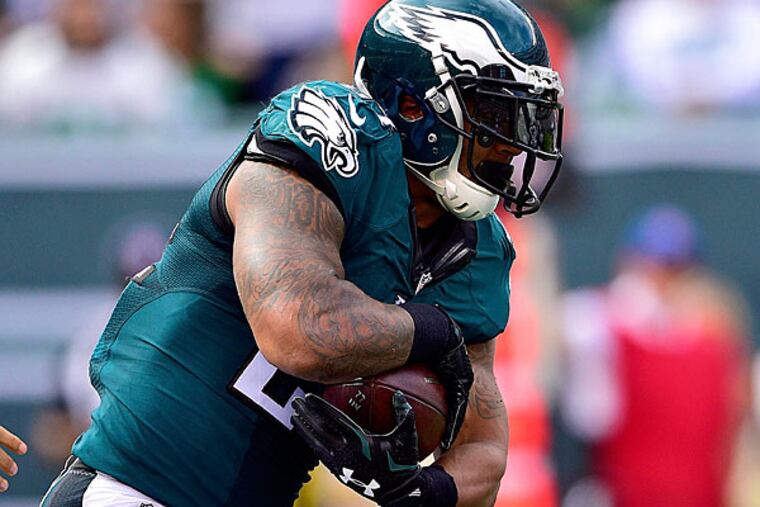Ryan Mathews could earn more carries
Did the Eagles running game rebound because of Ryan Mathews or did he benefit from a better plan and improved blocking?

Did the Eagles running game rebound because of Ryan Mathews or did he benefit from a better plan and improved blocking?
If Chip Kelly comes to the conclusion that it was the former, there could be a change at the top of the running back pyramid or at least a more even snap distribution when the injured DeMarco Murray returns to the lineup.
More than likely, the Eagles coach will digest the entire palate of possibilities and come to the conclusion that three games - two with Murray as the lead tailback and one with Mathews - are not enough of a sample to drastically alter his backfield.
"DeMarco fits in perfectly with what we are doing and Ryan fits in perfectly with what we are doing, and so does [Darren Sproles]," Kelly said Monday. "God willing and the pope can bless us again, all three of them will be available to us on Sunday against the Redskins."
Murray missed the victory over the New York Jets with a hamstring injury. He was a game-time decision. Assuming he doesn't aggravate the muscle strain - the same injury limited him during the preseason - Murray should be healthy enough for the Redskins.
If Kelly were to decide that he wanted to get Mathews more involved in the ground game, Murray's return could offer a cover. Of course, the initial point in signing both was to lessen the load for two aging running backs who have had their share of injuries and their share of carries.
It's difficult to look at the woeful running game in the first two games and draw conclusions, but Murray was clearly the primary option out of the backfield. He played 56 percent of the snaps and logged 21 of 31 carries. Sproles, who also lines up as a receiver, played 30 percent and had six carries. And Mathews played only 16 percent and rushed four times.
Only Sproles had success on the ground, and it came on five carries against the Falcons in Week 1. But no one could do anything against the Cowboys last week. Murray shouldered the load with 13 carries for 2 yards, while Mathews (one rush for no yards) and Sproles (one rush for negative-4 yards) couldn't get going, either.
There might have been one run when Murray could have gone one way rather than the other and gotten more yards. But he was consistently met in the backfield by defenders. Kelly mixed up his running plays and formations, but execution and the Cowboys were the main reasons the Eagles were held to 7 yards.
The Eagles' game plan for the Jets similarly had a different flavor than the vanilla one used in the opener in Atlanta. Quarterback Sam Bradford took more snaps from under center, there was more diversity in pre-snap formations, a few unbalanced lines, and the outside zone run became the go-to play for an offense that relied on the inside zone in Kelly's first two seasons.
Mathews thrived on the outside zone plays. He motored around the corner for 27 yards on his first carry - breaking two tackles along the way - and later picked up an additional 40 yards on eight outside zone runs.
"I think all of our backs are good runners on the outside zone play if it's blocked well," Eagles center Jason Kelce said after the game. "He's a very dynamic back. Obviously, he's powerful, he's strong, fast, quick, has a lot of different attributes.
"Really, what got that play going today was the offensive line blocked it well at certain times."
But could Murray have gotten as many yards as Mathews, who finished with 108 yards total on 25 totes? Mathews broke at least five tackles over the course of the game..
"He's a physical runner," Kelly said. "He does a nice job with the ball in his hands and can break contact at the line of scrimmage."
Sproles didn't have as much success. He gained only 17 yards on 11 carries.
Bradford took every snap in the shotgun against the Falcons, but he was under center for four of 15 rushes against Dallas. On Sunday, 13 of 36 handoffs came from under center. Last season, LeSean McCoy said that he preferred to receive the ball that way.
"I like running the ball from the shotgun," Mathews said after the game, "but I think I can see the field a lot more when the quarterback is not in shotgun formation."
Murray has said that he doesn't have a preference, but some running backs want to get more of a running start.
Mathews rushed for 42 yards on nine carries (4.7 average) under center and 66 yards on 16 carries (4.1) in the shotgun. Sproles finished with 8 yards on four tries (2.0) under center and 9 yards on seven tries (1.3) in the shotgun.
Having the quarterback under center gives defenses less of a bead on the path of the running back after the handoff. It also can open up play-action passes, although the Eagles did little of that against the Jets. They had the lead throughout and Mathews was making the best of his opportunity.
"I knew what I was signing up for when I signed with the team," Mathews said. "We have DeMarco Murray and Darren Sproles. Both of them are great running backs. I just tried to wait for my number to be called."
It may be called more often from here out.
@Jeff_McLane